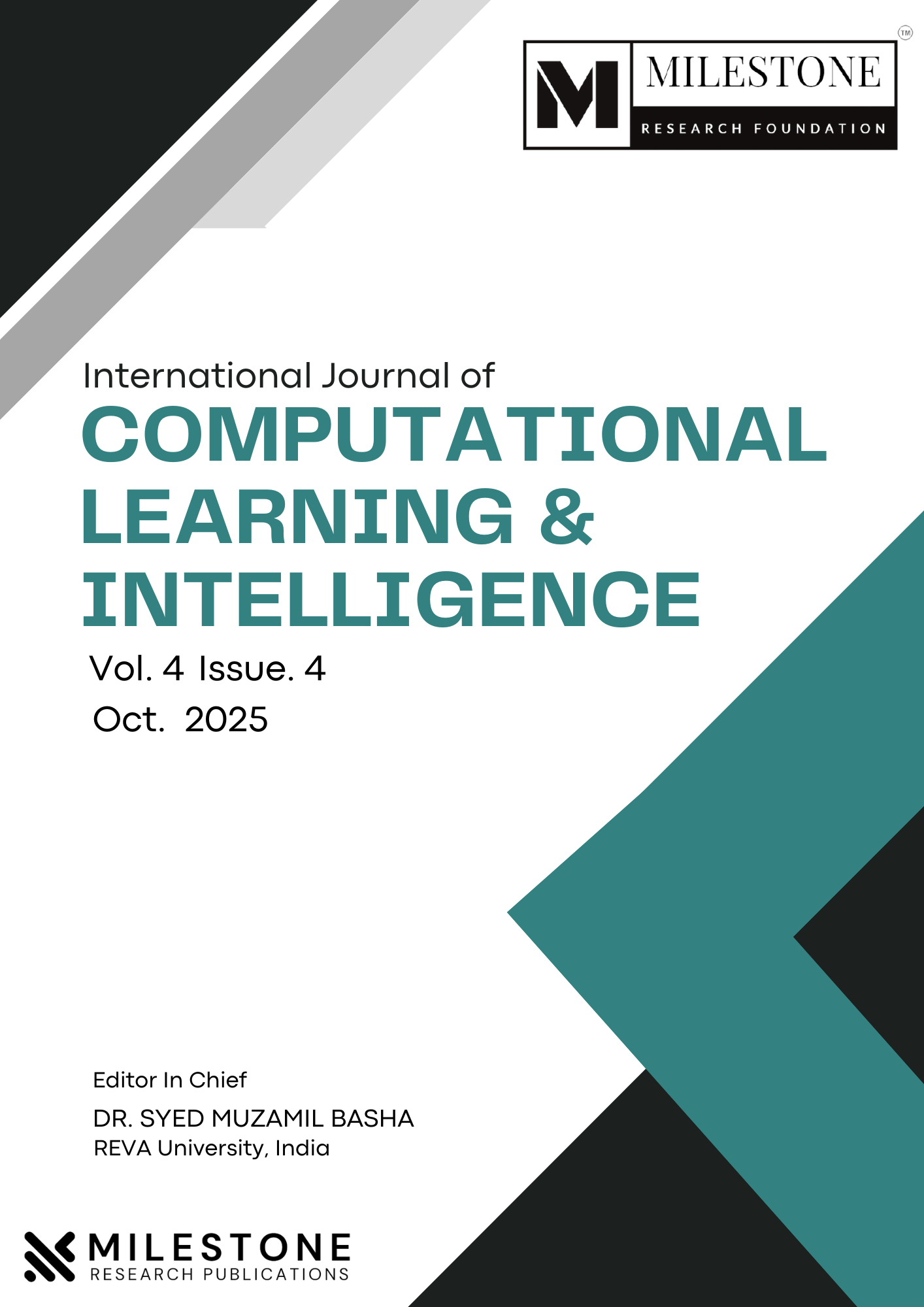AI-Augmented Fraud Detection and Cybersecurity Framework for Digital Payments and E-Commerce Platforms
Published 2025-06-09
Keywords
- AI in Cybersecurity,
- Fraud Detection,
- Digital Payments,
- Anomaly Detection,
- Behavioral Analytics
- Deep Learning ...More
How to Cite
Copyright (c) 2025 Haranadha Reddy Busireddy Seshakagari, Deventhira HariramNathan

This work is licensed under a Creative Commons Attribution-NonCommercial-NoDerivatives 4.0 International License.
Abstract
Advanced fraud detection techniques are becoming more and more necessary as e-commerce and digital transactions continue to grow. The intricacy and changing nature of fraudulent actions can make it difficult for traditional rule-based systems to keep up. To tackle this challenge, this research presents a hybrid fraud detection framework that combines several machine learning techniques, including Logistic Regression, XGBoost, a fusion of Autoencoder with XGBoost, and Graph Neural Networks (GNN). The proposed system also integrates behavioral pattern analysis and real-time risk evaluation, enabling it to adapt swiftly to new threats. Comprehensive testing on both standard and real-world datasets demonstrates the strength of this approach. The Autoencoder-XGBoost combination emerged as the top performer, achieving 97.4% accuracy with precision, recall, and F1-score, all at 0.96, and operating with a latency of just 100 milliseconds. The GNN model also delivered strong results, reaching 96.7% accuracy, a precision of 0.95, a recall of 0.94, and an F1-score of 0.945 while maintaining a lower latency of 88 milliseconds. Comparatively, traditional models like Logistic Regression and standalone XGBoost achieved 89.5% and 94.2% accuracy, respectively. These results highlight the improved effectiveness of hybrid approaches in identifying fraud within modern digital ecosystems.
References
- Patel, P., & Kaur, J. (2025). Introduction to brand management in the digital age. In Strategic brand management in the age of AI and disruption (pp. 1–26). IGI Global Scientific Publishing.
- Nabila, S., & Fasa, M. I. (2025). Digital transformation and Generation Z’s interest in Islamic banking products: Evidence from Lampung Province. DEAL: International Journal of Economics and Business, 3(01), 56–61.
- Ndibe, O. S. (2025). AI-driven forensic systems for real-time anomaly detection and threat mitigation in cybersecurity infrastructures. [Manuscript in preparation or unpublished work].
- Afzal, M., Meraj, M., Kaur, M., & Ansari, M. S. (2025). How does cybersecurity awareness help in achieving digital financial inclusion in rural India under escalating cyber fraud scenario? Journal of Cyber Security Technology, 9(2), 88–126.
- Al Obaidi, B. S. H., Al Kareem, R. S., Kadhim, A. T., & Korchova, H. (2025). The ripple effects of fraud on businesses: Costs, reputational damage, and legal consequences. Encuentros: Revista de Ciencias Humanas, Teoría Social y Pensamiento Crítico(23), 345–371.
- Tarade, R., & Das, S. (2025). Cybersecurity in the age of AI—Enhancing defences for today’s threats. In Critical phishing defense strategies and digital asset protection (p. 309).
- Singh, N., Jain, N., & Jain, S. (2025). AI and IoT in digital payments: Enhancing security and efficiency with smart devices and intelligent fraud detection. International Research Journal of Modernization in Engineering Technology and Science, 6(12), 982–991.
- Pathak, D. N., Kumar, A., Srivastava, K., Ranjan, R., Kaur, K., & Singh, R. (2025). Improving e-commerce fraud detection: A GAN and reinforcement learning approach integrated with personality analysis for secure digital economy. In 2025 International Conference on Visual Analytics and Data Visualization (ICVADV) (pp. 201–206). IEEE.
- Bolla, R. L., Ayyadurai, R., Parthasarathy, K., Panga, N. K. R., Bobba, J., & Ogundokun, R. O. (2025). Cloud and IoT data-based real-time fraud detection in e-commerce transactions using FSMNN approach. Service Oriented Computing and Applications, 1–17.
- Gopalsamy, M. (2025). Enhancing financial security based on machine learning techniques for anomaly detection in fraud transactions. [Manuscript in preparation or unpublished work].
- Islam, M. M., Zerine, I., Rahman, M. A., Islam, M. S., & Ahmed, M. Y. (2024). AI-driven fraud detection in financial transactions: Using machine learning and deep learning to detect anomalies and fraudulent activities in banking and e-commerce transactions. [Manuscript in preparation or unpublished work].
- Mahesar, A. J., Wighio, A. A., Imtiaz, N., Jamali, A., Nawaz, Y., & Urooj, U. (2025). Predicting tax evasion using machine learning: A study of e-commerce transactions. Spectrum of Engineering Sciences, 3(4), 840–852.
- Mahveen, Z. (2025). Optimizing fraud detection in healthcare: A hybrid machine learning approach. [Manuscript in preparation or unpublished work].
- Mienye, I. D., & Swart, T. G. (2025). Deep autoencoder neural networks: A comprehensive review and new perspectives. Archives of Computational Methods in Engineering, 1–20.
- Leveni, F., Cassales, G. W., Pfahringer, B., Bifet, A., & Boracchi, G. (2025). Online isolation forest. arXiv Preprint arXiv:2505.09593. https://arxiv.org/abs/2505.09593
- Ahmed, S. T., Fathima, A. S., Nishabai, M., & Sophia, S. (2024). Medical ChatBot assistance for primary clinical guidance using machine learning techniques. Procedia Computer Science, 233, 279-287.
- Ahmed, S. T., Priyanka, H. K., Attar, S., & Patted, A. (2017, June). Cataract density ratio analysis under color image processing approach. In 2017 International Conference on Intelligent Computing and Control Systems (ICICCS) (pp. 178-180). IEEE.
- Sreedhar Kumar, S., Ahmed, S. T., Mercy Flora, P., Hemanth, L. S., Aishwarya, J., GopalNaik, R., & Fathima, A. (2021, January). An Improved Approach of Unstructured Text Document Classification Using Predetermined Text Model and Probability Technique. In ICASISET 2020: Proceedings of the First International Conference on Advanced Scientific Innovation in Science, Engineering and Technology, ICASISET 2020, 16-17 May 2020, Chennai, India (p. 378). European Alliance for Innovation.
- Raja, D. K., Kumar, G. H., Basha, S. M., & Ahmed, S. T. (2022). Recommendations based on integrated matrix time decomposition and clustering optimization. International Journal of Performability Engineering, 18(4), 298.

